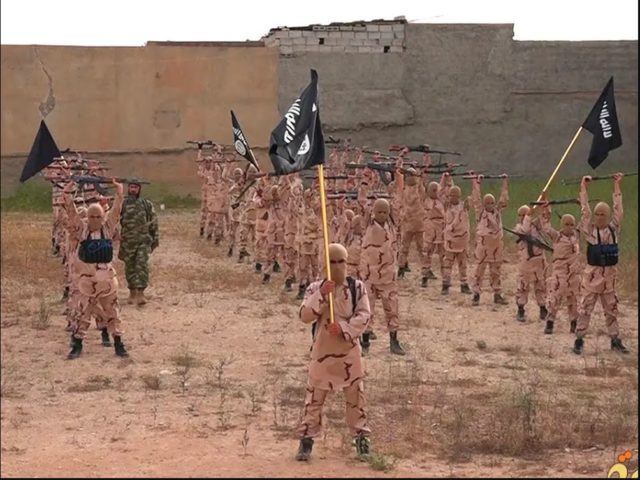
Islamic State in West Africa Province Video Signals the Group’s Grand Strategy for the Future
Publication: Terrorism Monitor Volume: 20 Issue: 5
By:

On January 18, 2022, Islamic State West Africa Province (ISWAP), which is the Islamic State (IS)’s affiliate in Nigeria and the Lake Chad basin, released a 27-minute propaganda video titled “The Empowerment Generation” on its official media platform (Ujasusi, January 23). The video provides exclusive access into what ISWAP refers to as its “Khilafah [Caliphate] Cadet School.” It features young children between 8-16 years old undergoing religious indoctrination and physical training involving martial arts and arms. It even shows the trainees executing three members of the Nigerian Special Forces. This video suggests that IS has a well-developed, long-term strategy to provide a continuous supply of youth fighters to replenish and rejuvenate its ranks.
IS and the “Cubs of the Caliphate” in Nigeria
The “Cubs of the Caliphate” was a term coined by IS to refer to its child recruits. The use of children in IS propaganda videos is not a new phenomenon and IS has produced numerous videos showcasing children of various nationalities, including Southeast Asians, Central Asians and Middle Easterners, between 2014-2017 (icsr.info, July 2018).
After a multi-year hiatus, one possibly due to restructuring within the group after the fall of the “territorial caliphate” in 2019, “The Empowerment Generation” from ISWAP highlights that IS is still interested in investing resources into grooming youngsters for its next generation of fighters. The video features similar themes as previous IS videos, including an emphasis on religious education and classroom studies; military-style physical and arms training; and the execution of hostages. In essence, this exemplifies the three key aspects of an IS fighter, which are ideological indoctrination, the need to fight, and the ability to execute enemies.
A key highlight of the ISWAP video, however, is the level of inside information revealed regarding the training program. In an extended interview, one of the trainers states that the Khilafah Cadet School is comprised of a Sharia Law Institute, a Quran halaqah (discussion group), and a physical training camp. The students in the film were the first batch at the school.
The trainer further disclosed that the recruits in the school undergo a strict selection process. After several years of Quranic training, prospective recruits must sit for an entry examination conducted by an Education Department. Only those who fulfill the entry qualifications are selected. The four main themes emphasized throughout the training program are loyalty; jihad; hijrah (migration) and jemaah (congregation).
The Strategic Importance of Africa and Youth to IS through the Video Lens
This video is the most detailed IS video involving children to be released. It is meant to showcase a day in the life of a trainee at the school. Their daily schedule appears to be highly regimented and includes Quran recital sessions, multiple prayer sessions, a classroom study session where they learn aqidah (Islamic creed), fiqh (Islamic jurisprudence), hadith (sayings of the Prophet), and Arabic language. There is also a session where they watch IS propaganda videos and another that involves two physical training sessions that include self-defense and arms training. The group of trainees are also shown making the bayah (oath of allegiance) to Abu Ibrahim al-Quraishi, the former IS leader who was reportedly killed on February 3 (thearabweekly.com, February 8). Towards the end of the video, the children are finally seen engaging in urban warfare exercises where they move into an abandoned building in a highly coordinated manner. They capture several hostages, who are actually Nigerian soldiers caught by ISWAP in previous battles, and then proceed to execute them.
The release of this video highlights the emphasis IS has placed on its African presence. The region is one of the new epicenters of jihad after Iraq and Syria. Based on previous trends, IS usually releases training videos of children only from areas that are its strongholds. At the peak of IS activity in the mid-2010s, most of the videos featuring “cubs” came from Iraq and Syria where IS controlled territory. This video coming out of Nigeria signals that the northeastern region of the country appears to be a new stronghold. Indeed, Nigeria saw the second highest number of claimed attacks by IS in 2021, only after Iraq (Jihad Analytics, January 24).
In addition, the video highlights a level of structure and organization for the children’s training curriculum that has never been seen before in IS videos. This suggests that IS has a long-term strategy of cultivating the younger generation as fighters for the group. This is reflected in a quote by one of the trainers in the video. He states, “To fulfill our long-term ambitions, we have devised a long-term plan to prepare the boys who will defeat kufr (disbelief) with Islamic millah (foundational principles) and aqidah (creed). Although the Islamic State has been going through a tough battle for the last few years, we have created an integrated program in educating and guiding these youth.”
Conclusion
The threat posed by IS as evidenced in the video is not localized to Africa or the Middle East. After the release of the video, an Indonesian IS-affiliated media channel, an-Najiyah, released both a 21-page document titled “Generasi Tamkin,” which means “The Empowerment Generation” in the Indonesian-language, and the same ISWAP video with Indonesian-language subtitles. Thus, the idea of training and preparing the youth as the next generation of fighters may resonate with IS’s affiliates in Southeast Asia.
IS’s strategy to recruit and cultivate youths is focused on preparing the next generation to be fighters undertaking the group’s mission internationally. A recent United Nations Security Council report noted that IS had “recently reinstated their Cubs of the Caliphate program” to form the next generation of IS (United Nations Security Council, January 28). Thus, authorities throughout the world will need to monitor IS attempts to raise more “cubs” as part of its long-term grand strategy.



